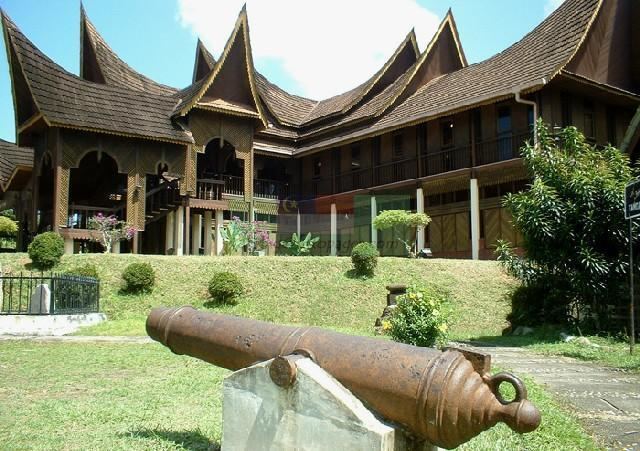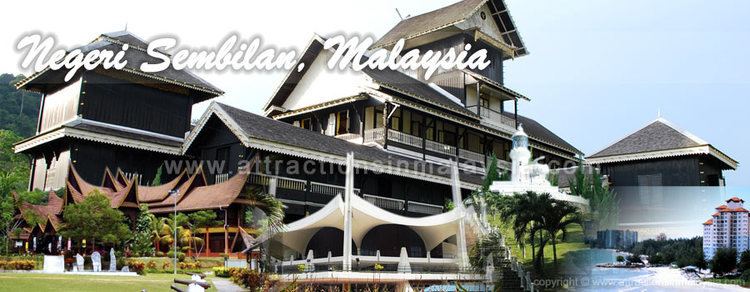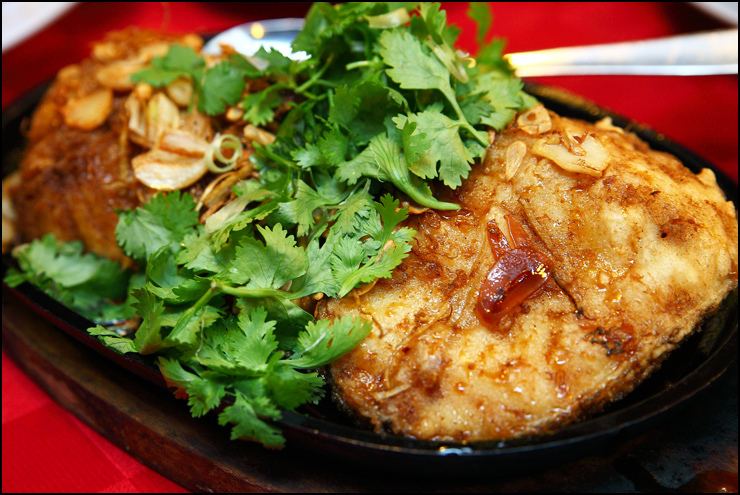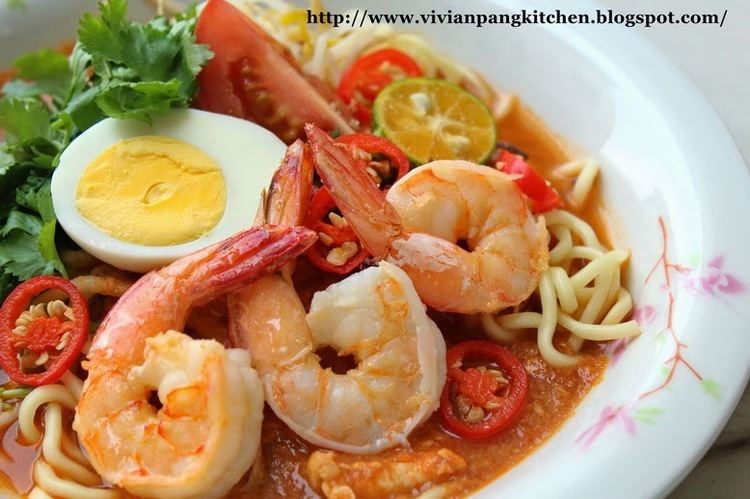Area 6,686 km2 Population 1.08 million (2013) | Capital | |
 | ||
Destinations Points of interest Kota Lukut, Tanjung Tuan, Cape Rachado Lighthouse, PD Ostrich Farm, Muzium Tentera Darat | ||
Map of Negeri Sembilan
Negeri Sembilan ([ˈnəgəri səmbiˈlan]) is a state in Malaysia which lies on the western coast of Peninsular Malaysia. It borders Selangor on the north, Pahang in the east, and Melaka and Johor to the south.
Contents
- Map of Negeri Sembilan
- matriculation college of negeri sembilan kmns cny mv 20142015
- food moments 25 jan 2015
- History
- Population and demographics
- Religion
- Languages
- Constitution
- The Ruler
- State Executive Council
- Economy
- Culture
- Dances
- Cuisine
- Tourism
- Districts
- List of local authorities
- Education
- Hospitals
- Television
- References

The name is believed to derive from the nine (sembilan) villages or nagari in the Minangkabau language (now known as luak) settled by the Minangkabau, a people originally from West Sumatra (in present-day Indonesia). Minangkabau features are still visible today in traditional architecture and the dialect of Malay spoken.

Unlike the hereditary monarchs of the other royal Malay states, the ruler of Negeri Sembilan is known as Yang di-Pertuan Besar instead of Sultan. The election of the Ruler is also unique. He is selected by the council of Undangs who lead the four biggest territories of Sungai Ujong, Jelebu, Johol, and Rembau, making it one of the more democratic monarchies.

The capital of Negeri Sembilan is Seremban. The royal capital is Seri Menanti in Kuala Pilah District. Other important towns are Port Dickson, Bahau and Nilai.

The Arabic honorific title of the state is Darul Khusus ("the Special Abode").

matriculation college of negeri sembilan kmns cny mv 20142015
food moments 25 jan 2015
History
The earliest inhabitants of Negeri Sembilan were the ancestors of the Semelai, Semai, Semang, and Jakun peoples, who lived either as hunter-gatherer nomads or as subsistence farmers.
The Minangkabaus from Sumatra settled in Negeri Sembilan in the 15th century (the 1400s) under the protection of the Malacca Sultanate, and later under the protection of its successor, the Sultanate of Johor. Negeri Sembilan is a state which has matrilineal society majority . The matrilineal custom was brought by the Minangkabau.
As Johor weakened in the 18th century, attacks by the Bugis forced the Minangkabaus to seek protection from their homeland. The Minangkabau ruler, Sultan Abdul Jalil, obliged by sending his near relative, Raja Melewar. When he arrived, he found that another royal, Raja Khatib had already established himself as ruler. He declared war against Raja Khatib and became the ruler of Negeri Sembilan. The Sultan of Johor confirmed his position by granting the title Yamtuan Seri Menanti (He Who is Highest Lord of the Seri Menanti) in 1773. After Raja Melewar's death, a series of disputes arose over the succession. For a considerable period, the local nobles applied to the Minangkabau ruler in Sumatra for a ruler. However, competing interests supported different candidates, often resulting in instability and civil war.
In 1873, the British intervened militarily in a civil war in Sungai Ujong to preserve British economic interests, and placed the country under the control of a British Resident. Jelebu followed in 1886, and the remaining states in 1895. In 1897, when the Federated Malay States (FMS) was established, Sungai Ujong and Jelebu were reunited to the confederation of small states and the whole, under the old name of the Negeri Sembilan, was placed under a single Resident and became a member of the FMS.
The number of states within Negeri Sembilan has fluctuated over the years, the federation now consists of six states and a number of sub-states under their suzerainty. The former state of Naning was annexed to Malacca, Klang to Selangor, and Segamat to Johor.
Negeri Sembilan endured Japanese occupation in World War II between 1942 and 1945, and joined the Federation of Malaya in 1948, and became a state of Malaysia in 1963.
Population and demographics
Negeri Sembilan have seven districts.
Negeri Sembilan has a collective population of 1,098,400 as of 2015; the ethnic composition consisting of Malay 56.6% (mostly are Minangkabau descent), other Bumiputras 20,700 (1.9%), Chinese 234,300 (21.3%), Indian 154,000 (14%), Others 4,200 (0.4%), and Non Citizens 63,300 (5.8%). The state has the highest percentage of Indians when compared to other Malaysian states.
Religion
According to the 2010 census, the population of Negeri Sembilan is 60.3% Muslim, 21.2% Buddhist, 13.4% Hindu, 2.4% Christian, 0.5% Taoist or Chinese religion follower, 0.3 of followers of other religions, 1.1% of unknown affiliation, and 0.8% non-religious.
Languages
Negeri Sembilan is a multiethnic state in which every ethnic groups speak their own respective languages and dialects. The Negeri Sembilanese people speak a unique variety of Malay known as Negeri Sembilan Malay or in their native language as Baso Nogoghi. It is not closely related to other varieties of Malay in Peninsular Malaysia but more closely related with Malay varieties spoken in neighbouring Sumatra especially varieties of Minangkabau. Besides Malays, the Chinese and Indian communities also speak their own languages and dialects. Orang Asli peoples like Temuans speak a language closely related to Malay. Standard Malay is widely used throughout the state.
Constitution
The Constitution of Negeri Sembilan came into force on 26 March 1959. It is divided into two sections. The constitution establishes that the state's form of government is constitutional monarchy and the world's only elective monarchy for matrilineal society. The system was partially the basis for the federal monarchy.
The Ruler
The official constitutional title of the Ruler of the state are Duli Yang Maha Mulia Yang di-Pertuan Besar Negeri Sembilan, (currently Duli Yang Maha Mulia Yang di-Pertuan Besar Negeri Sembilan Darul Khusus Tuanku Muhriz ibni Almarhum Tuanku Munawir), Yang Teramat Mulia Undang of Sungei Ujong, Yang Teramat Mulia Undang of Jelebu, Yang Teramat Mulia Undang of Johol, Yang Teramat Mulia Undang of Rembau and Yang Teramat Mulia Tengku Besar Tampin and they holds office for life.
The state's constitution proclaims the Yang di-Pertuan Besar, Undang of Sungei Ujong, Undang of Jelebu, Undang of Johol, Undang of Rembau and Tengku Besar Tampin are vested with the Executive Power of the state, are the Head of the Religion of Islam in the state and are the fountain of all honour and dignity for the state. The current Yang di-Pertuan Besar is His Royal Highness Tuanku Muhriz ibni Almarhum Tuanku Munawir. His Royal Highness succeeds Almarhum Tuanku Jaafar Ibni Almarhum Tuanku Abdul Rahman who died on 27 December 2008.
Unlike Malaysia's eight other Royal Malay states, the Ruler of Negeri Sembilan is elected to his office by the territorial chiefs or Ruling Chiefs of the state. These Ruling Chiefs are titled Undang. Only four of the Undangs have the right to vote in the election for the Ruler of the State. They are:
The Undang themselves cannot stand for election and their choice of ruler is limited to a male Muslim who is Malay and also a "lawfully begotten descendant of Raja Radin ibni Raja Lenggang".
State Executive Council
The State Executive Council is established by the 1959 constitution. It consists of the Menteri Besar, who is its Chairman, and ten other members. The Menteri Besar and the other members of the council are appointed by the Yang Di-Pertuan Besar from the members of the State Assembly. The current Menteri Besar or Chief Minister of the state is Dato' Seri Utama Muhammad Hassan.
Economy
The state's manufacturing sector contributing almost half of the state’s gross domestic product (GDP), followed by services and tourism (40.3%), agriculture (6%), construction (2.2%) and mining (0.3%). Manufacturing activity includes electrical and electronics, textiles, furniture, chemicals, machinery, metal works and rubber products. The main industrial areas are Senawang, Sungai Gadut, Tuanku Jaafar Industrial Park, Nilai and Tanah Merah in Port Dickson. Coca-Cola, which is in the midst of setting up its billion ringgit bottling plant in Bandar Enstek.
Negeri Sembilan is mainly an agricultural state. However, the establishment of several industrial estates enhanced the manufacturing sector as a major contributor towards the state economy.
Agricultural activity includes rubber and oil palm plantations, livestock, fruit orchards and vegetable farming. About 3,099 square kilometres are used for rubber and oil palm plantations.
Culture
The Minangkabau people brought along with them a cultural heritage which is still preserved and practised today as the Adat perpatih, a matrilineal system of inheritance and administration that is unique to the state. It is a system where the husband is the head of the household and inheritance passes from the mother to the daughter. The Minangkabau's divided into twelve suku or tribes, and marriage between members of the same tribe or clan is forbidden. The Minangkabau influence in the state can be found in dances and food as well.
Dances
Negeri Sembilan also has traditional music like the Caklempong, Dikir Rebana, Tumbuk Kalang, and Bongai.
The musical instruments used bear some semblance to Sumatra, the ancestral home of the Minangkabau people. Dances like the tarian lilin (candle dance) and rentak kuda (beat of the horse) are popular in Negeri Sembilan and the coordinated movements of the dancers in their colorful costumes in the Tarian Piring and the upbeat tempo of Tarian Randai. Unlike modern dance, each beat, rhythm and movement in these dances combines to form a story, maybe of a bygone myth or simply a reflection of the lifestyles of another era.
They are usually performed at traditional festivities, cultural events and dinner-cum-cultural shows.
Cuisine
Traditional Negeri Sembilan food is hot and spicy, as one of the ingredients used is the chili padi, the hottest of chili peppers. Popular dishes includes rendang, (pieces of beef cooked in coconut milk and chillies). One should experience the unique Minangkabau style of cooking, which sees generous portions of 'chili padi' (small and extremely hot chilies) being used. Try the "Masak Lemak Cili Padi - fish, meat, or vegetables cooked in coconut milk blended with turmeric and ground chili padi.The difference of "Masak Lemak Cili Padi" or the people often called it as "Gulai" in Negeri Sembilan with other state is there is no onions nor garlic used in making "Gulai".
Another Negeri Sembilan specialty is "Lemang", glutinous rice cooked in coconut milk in a bamboo stem over an open fire. This is normally served with Rendang, a deliciously thick and dry meat curry.
Tourism
The popular attractions in Negeri Sembilan are:
Districts
The state comprises 7 districts:
- Seremban
- Port Dickson
- Rembau
- Jelebu
- Kuala Pilah
- Jempol
- Tampin
It originally consisted of 9 districts:
List of local authorities
There are 8 local authorities in Negeri Sembilan, namely:
- Majlis Perbandaran Seremban (MPS)
- Majlis Perbandaran Nilai (MPN)
- Majlis Perbandaran Port Dickson (MPPD)
- Majlis Daerah Jelebu (MDJ)
- Majlis Daerah Jempol (MJL)
- Majlis Daerah Kuala Pilah (MDKP)
- Majlis Daerah Rembau (MDR)
- Majlis Daerah Tampin (MDT)
Education
Negeri Sembilan has several tertiary education institutions. Most of these education institutions are concentrated in major towns in Negeri Sembilan. The list below represents public and private university based in Negeri Sembilan state:
Hospitals
There are public hospitals and private hospitals in Negeri Sembilan:
Public Hospitals
Private Hospitals
Television
Television in Negeri Sembilan consists of seven free-to-air stations, and one satellite television network services. Three of the seven free-to-air stations are managed by Radio Televisyen Malaysia, a federal government-owned media company headquartered in Kuala Lumpur, while the four commercial stations are owned by Media Prima, an integrated media company headquartered in Bandar Utama, Selangor. The satellite television service is owned by Astro All Asia Networks and it is available nationwide.
Mainstream newspapers in Negeri Sembilan are:
